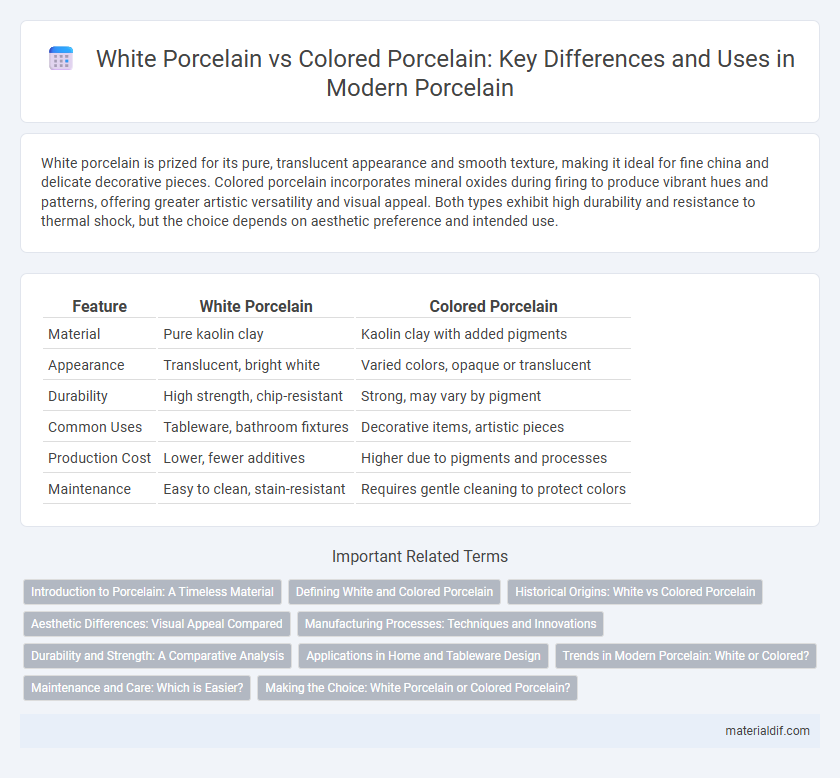White porcelain is prized for its pure, translucent appearance and smooth texture, making it ideal for fine china and delicate decorative pieces. Colored porcelain incorporates mineral oxides during firing to produce vibrant hues and patterns, offering greater artistic versatility and visual appeal. Both types exhibit high durability and resistance to thermal shock, but the choice depends on aesthetic preference and intended use.
Table of Comparison
| Feature | White Porcelain | Colored Porcelain |
|---|---|---|
| Material | Pure kaolin clay | Kaolin clay with added pigments |
| Appearance | Translucent, bright white | Varied colors, opaque or translucent |
| Durability | High strength, chip-resistant | Strong, may vary by pigment |
| Common Uses | Tableware, bathroom fixtures | Decorative items, artistic pieces |
| Production Cost | Lower, fewer additives | Higher due to pigments and processes |
| Maintenance | Easy to clean, stain-resistant | Requires gentle cleaning to protect colors |
Introduction to Porcelain: A Timeless Material
White porcelain, renowned for its pure, translucent appearance, offers a classic and elegant aesthetic favored in fine china and decorative arts. Colored porcelain incorporates mineral oxides during the firing process, resulting in vibrant hues that enhance design versatility and artistic expression. Both types maintain the material's hallmark durability, smooth texture, and resistance to thermal shock, making porcelain a timeless choice for functional and ornamental use.
Defining White and Colored Porcelain
White porcelain is characterized by its pure, translucent white body made primarily from kaolin clay, prized for its smooth texture and high durability. Colored porcelain incorporates metal oxides or other pigments during the production process, creating vibrant hues while maintaining the same durable properties of traditional white porcelain. Both types are valued in ceramics for their strength, aesthetic appeal, and versatility in artistic and functional applications.
Historical Origins: White vs Colored Porcelain
White porcelain originated in China during the Tang Dynasty, prized for its pure, translucent quality achieved through kaolin clay and high-temperature firing. Colored porcelain emerged later, notably in the Ming Dynasty, with intricate glazes and enamel decorations enhancing aesthetic and symbolic value. The contrasting historical origins reflect evolving technological advancements and cultural preferences across periods in Chinese ceramic artistry.
Aesthetic Differences: Visual Appeal Compared
White porcelain offers a timeless elegance with its smooth, translucent surface and pure, bright finish that enhances intricate design details. Colored porcelain introduces a dynamic visual appeal through vibrant hues and varied glazing techniques, allowing for bold artistic expression and personalized aesthetics. The contrast between the two lies in white porcelain's subtle sophistication versus colored porcelain's striking, eye-catching vibrancy.
Manufacturing Processes: Techniques and Innovations
White porcelain is typically crafted using kaolin clay fired at high temperatures to achieve its characteristic translucency and purity, with precise control over kiln atmospheres enhancing its whiteness and strength. Colored porcelain integrates mineral oxides or stains before firing, requiring advanced glazing techniques and temperature modulation to maintain color vibrancy and durability. Innovations such as digital printing and nano-glazing have optimized both white and colored porcelain manufacturing, improving precision, surface finish, and resistance to wear.
Durability and Strength: A Comparative Analysis
White porcelain exhibits higher durability and strength due to its dense, finely-grained composition and firing process at temperatures above 1,200degC, resulting in enhanced resistance to chipping and cracking. Colored porcelain, while aesthetically diverse, often incorporates additional pigments or glazes that may slightly reduce its structural integrity under extreme conditions. Comparative studies highlight white porcelain's superior performance in applications demanding long-lasting resilience and mechanical stability.
Applications in Home and Tableware Design
White porcelain is prized in home and tableware design for its classic elegance, durability, and ability to showcase intricate patterns without distraction, making it ideal for formal dining settings and minimalist interiors. Colored porcelain offers vibrant aesthetics and creative versatility, enhancing casual dining experiences and decorative accents through bold hues and innovative glazes. Both types adapt well to modern manufacturing techniques, ensuring functional strength and aesthetic appeal in everyday kitchen use and artistic home decor.
Trends in Modern Porcelain: White or Colored?
White porcelain remains a dominant trend in modern interiors due to its versatility, timeless elegance, and ability to create a clean, minimalist aesthetic. Colored porcelain is gaining popularity for adding bold accents and personalized touches, with vibrant blues, greens, and earthy tones becoming favored in contemporary design. Advances in porcelain glazing techniques allow for durable, color-rich finishes that combine functionality with artistic expression, making color choices more accessible and trend-driven.
Maintenance and Care: Which is Easier?
White porcelain requires less frequent cleaning to maintain its pristine appearance, as stains and discoloration are more visible on colored porcelain surfaces, necessitating more diligent care. Colored porcelain often demands specialized cleaning agents to preserve its vibrant hues and prevent fading over time. Both types benefit from gentle cleaning methods and avoiding abrasive materials to ensure longevity and maintain their aesthetic appeal.
Making the Choice: White Porcelain or Colored Porcelain?
White porcelain offers a classic, timeless appeal with its smooth, translucent surface and is ideal for minimalist or traditional designs. Colored porcelain introduces vibrant hues and personalized aesthetics, often used to create striking patterns or thematic decor. Choosing between white and colored porcelain depends on the desired visual impact, application environment, and maintenance considerations such as stain visibility and fading over time.
White Porcelain vs Colored Porcelain Infographic

 materialdif.com
materialdif.com